
Megan Schwarzman, 42, a research scientist at the Berkeley School of Public Health, was riding her bike southbound on Fulton Street near Bankcroft Way on Tuesday around 5 p.m. when she was hit and dragged under a car driven by Berwick Haynes, a Sunnyvale resident. Haynes remained at the scene and was later arrested for suspicion of driving under the influence of drugs, according to reports. Schwarzman's injuries were so severe that the Berkeley Police sent its “Fatal Accident Investigation Team.” Fortunately, Schwarzman is expected to live, reported Berkeleyside, an independent news site.
It's difficult to see what, if anything, Schwarzman could have done to ride more safely. Reportedly, she was wearing florescent green safety gear, a helmet, and she had lights on her bike. She was struck from behind. There's no way anyone can call this an “accident,” given the conditions on Fulton—its design encourages dangerous speeds and provides no protection for cyclists.
According to the Daily Californian citing data from the California Highway Patrol, there were ten reported bicycle-versus-motor vehicle collisions at the intersection of Fulton Street and Bancroft Way from 2001 to 2014. Meanwhile, Berkeley’s Mayor Tom Bates has declared that he wants to make Berkeley the most bike-friendly city in the US.
Then why do such conditions persist? It wasn't a cost issue: the city repaved Fulton last year. “We asked them to put in bike lanes and got our usual response that they need to do a traffic study,” said Dave Campbell, Advocacy Director for Bike East Bay. “We were told both would take time and they didn't want to delay the paving. It would have been very easy to do.”
Campbell said it's a problem endemic to Berkeley and other cities: the paving engineers work in a different department from the city planners. Putting protected bike lanes on Fulton “was in the 2000 bike plan. It was in the 2005 bike plan. It was in the 2010 downtown plan -- every five years the city says 'yes, do this' and then they repave without doing it,” said Campbell. He hopes that with the end of CEQA's car-centric “Level of Service" (LOS), things might improve, but he's fears the foot-dragging and excuses will continue.
Meanwhile, in San Fracisco, Market Street claimed another life. 38-year-old Thu Pham of Berkeley was fatally struck on Friday morning by a white Ford sedan making an illegal turn as Pham crossed at 7th. Pham was in a wheel chair. “The turn restrictions here were implemented by the Safer Market Street project. It’s important to note that the entire approach left lane is blocked off and signed as restricted,” explained Ben Jose, a spokesman for SFMTA, and private cars are not permitted to make that turn.
“We need to understand why he turned,” said Nicole Ferrara, Executive Director of Walk SF. “There are certain things that aren't correctly cuing drivers and we need to know what they are as the city designs the streets." She stressed that, as with the incident in Berkeley, the “answer is engineering. Market Street needs to be safe for people with disabilities, seniors and children. That has to be our baseline treatment.”
One wonders, however, how it can be safe for trucks to turn left, but not cars. Ferrara said that exception was a compromise to build consensus for Safer Market. Without that compromise, perhaps physical obstructions could be installed to make those left turns difficult to make.
It seems politicians, business interests, and the different city agencies are often quick to find reasons to compromise safety and delay improvements. The tools are there to fix our streets and there are proven designs to copy. “There is no mystery here,” said Campbell. "We know how to do it.”
With LOS gone, perhaps there needs to be legislation that holds individual leaders inside bureaucracies responsible when foot dragging and avoidable compromises on safety are linked to deaths and serious injuries. Because clearly, our streets are not getting fixed fast enough.





